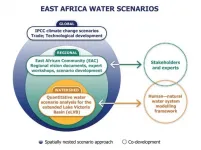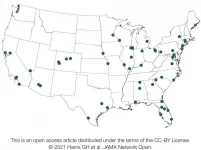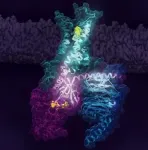(Press-News.org) LOS ALAMOS, N.M., March 19, 2021--Many machine learning algorithms on quantum computers suffer from the dreaded "barren plateau" of unsolvability, where they run into dead ends on optimization problems. This challenge had been relatively unstudied--until now. Rigorous theoretical work has established theorems that guarantee whether a given machine learning algorithm will work as it scales up on larger computers.
"The work solves a key problem of useability for quantum machine learning. We rigorously proved the conditions under which certain architectures of variational quantum algorithms will or will not have barren plateaus as they are scaled up," said Marco Cerezo, lead author on the paper published in Nature Communications today by a Los Alamos National Laboratory team. Cerezo is a post doc researching quantum information theory at Los Alamos. "With our theorems, you can guarantee that the architecture will be scalable to quantum computers with a large number of qubits."
"Usually the approach has been to run an optimization and see if it works, and that was leading to fatigue among researchers in the field," said Patrick Coles, a coauthor of the study. Establishing mathematical theorems and deriving first principles takes the guesswork out of developing algorithms.
The Los Alamos team used the common hybrid approach for variational quantum algorithms, training and optimizing the parameters on a classical computer and evaluating the algorithm's cost function, or the measure of the algorithm's success, on a quantum computer.
Machine learning algorithms translate an optimization task--say, finding the shortest route for a traveling salesperson through several cities--into a cost function, said coauthor Lukasz Cincio. That's a mathematical description of a function that will be minimized. The function reaches its minimum value only if you solve the problem.
Most quantum variational algorithms initiate their search randomly and evaluate the cost function globally across every qubit, which often leads to a barren plateau.
"We were able to prove that, if you choose a cost function that looks locally at each individual qubit, then we guarantee that the scaling won't result in an impossibly steep curve of time versus system size, and therefore can be trained," Coles said.
A quantum variational algorithm sets up a problem-solving landscape where the peaks represent the high energy points of the system, or problem, and the valleys are the low energy values. The answer lies in the deepest valley. That's the ground state, represented by the minimized cost function. To find the solution, the algorithm trains itself about the landscape, thereby navigating to the low spot.
"People have been proposing quantum neural networks and benchmarking them by doing small-scale simulations of 10s (or fewer) few qubits," Cerezo said. "The trouble is, you won't see the barren plateau with a small number of qubits, but when you try to scale up to more qubits, it appears. Then the algorithm has to be reworked for a larger quantum computer."
A barren plateau is a trainability problem that occurs in machine learning optimization algorithms when the problem-solving space turns flat as the algorithm is run. In that situation, the algorithm can't find the downward slope in what appears to be a featureless landscape and there's no clear path to the energy minimum. Lacking landscape features, the machine learning can't train itself to find the solution.
"If you have a barren plateau, all hope of quantum speedup or quantum advantage is lost," Cerezo said.
The Los Alamos team's breakthrough takes an important step toward quantum advantage, when a quantum computer performs a task that would take infinitely long on a classical computer. Achieving quantum advantage hinges in the short term on scaling up variational quantum algorithms. These algorithms have the potential so solve practical problems when quantum computers of 100 qubits or more become available--hopefully soon. Quantum computers currently max out at 65 qubits. A qubit is the basic unit of information in a quantum computer, as bits are in a classical digital computer.
"The hottest topic in noisy intermediate-scale quantum computers is variational quantum algorithms, or quantum machine learning and quantum neural networks," Coles said. "They have been proposed for applications from solving the structure of a molecule in chemistry to simulating the dynamics of atoms and molecules and factoring numbers."
INFORMATION:
The paper: "Cost function dependent barren plateaus in shallow parametrized quantum circuits," Nature Communications, by M. Cerezo, Akira Sone, Tyler Volkoff, Lukasz Cincio, and Patrick J. Coles. DOI: 10.1038/s41467-021-21728-w
https://www.nature.com/articles/s41467-021-21728-w
Funding: Los Alamos National Laboratory's Laboratory Directed Research and Development (LDRD), the Center for Nonlinear Studies at Los Alamos, the ASC Beyond Moore's Law project at Los Alamos, and the U.S. Department of Energy (DOE), Office of Science, Office of Advanced Scientific Computing Research.
About Los Alamos National Laboratory
Los Alamos National Laboratory, a multidisciplinary research institution engaged in strategic science on behalf of national security, is managed by Triad, a public service oriented, national security science organization equally owned by its three founding members: Battelle Memorial Institute (Battelle), the Texas A&M University System (TAMUS), and the Regents of the University of California (UC) for the Department of Energy's National Nuclear Security Administration.
Los Alamos enhances national security by ensuring the safety and reliability of the U.S. nuclear stockpile, developing technologies to reduce threats from weapons of mass destruction, and solving problems related to energy, environment, infrastructure, health, and global security concerns.
LA-UR-21-22516 Version 2
Notwithstanding last month's cold snap in Texas and Louisiana, climate change is leading to warmer winter weather throughout the southern U.S., creating a golden opportunity for many tropical plants and animals to move north, according to a new study appearing this week in the journal Global Change Biology.
Some of these species may be welcomed, such as sea turtles and the Florida manatee, which are expanding their ranges northward along the Atlantic Coast. Others, like the invasive Burmese python -- in the Florida Everglades, the largest measured 18 feet, end-to-end --maybe less so.
Equally unwelcome, and among the quickest to spread into warming areas, are ...
In light of recent extreme climate events--from wildfires blazing through the western US to snowstorms sweeping Texas into a blackout--climate scientists and media outlets have repeatedly called out the urgency of tackling the climate crisis. But in a new study published March 19 in the journal One Earth, researchers found that emphasizing urgency alone is not enough to kindle public support for climate change policies.
"We had the impression that policymakers shy away from enacting ambitious, stringent climate policy because they're afraid of ...
IIASA researchers worked with local stakeholders from the East African Community to explore and co-develop regional water scenarios that can enhance understanding of the up- and downstream water sector interactions in the extended Lake Victoria Basin to facilitate rational water resource planning.
East Africa is the world's fastest growing region outside of Asia, with an estimated growth of 5% and above over the last decade. Part of this success can likely be attributed to the East Africa Vision 2050, which was launched in 2015 by the Heads of States of the East African Community (EAC) - an intergovernmental organization composed of six countries in the African Great Lakes ...
PITTSBURGH, March 19, 2021 - A University of Pittsburgh School of Medicine-led survey of dozens of surge capacity managers at hospitals nationwide captures the U.S. health care system's pandemic preparedness status in the months before the first COVID-19 cases were identified in China.
Published today in the journal JAMA Network Open, the investigation details the strain experienced by U.S. hospitals during the 2017-18 influenza season, which was marked by severe illness and the highest infectious disease-related hospitalization rates in at least a decade. At the time, pandemic planning ...
A new research study at the University of Chicago Medicine has found that when it comes to COVID-19, having vitamin D levels above those traditionally considered sufficient may lower the risk of infection, especially for Black people.
The study, published March 19 in JAMA Open Network, retrospectively examined the relationship between vitamin D levels and likelihood of testing positive for COVID-19. While levels of 30 ng/ml or more are usually considered "sufficient," the authors found that Black individuals who had levels of 30 to 40 ng/ml had a 2.64 times higher risk of testing ...
What The Study Did: This analysis examined how patients with multiple sclerosis who have COVID-19 fare and what patient and disease characteristics are associated with worse outcomes.
Authors: Amber Salter, Ph.D., of Washington University in St Louis, is the corresponding author.
To access the embargoed study: Visit our For The Media website at this link https://media.jamanetwork.com/
(doi:10.1001/jamaneurol.2021.0688)
Editor's Note: The article includes conflict of interest and funding/support disclosures. Please see the article for additional information, including other authors, author contributions and affiliations, conflict of interest and financial disclosures, ...
What The Study Did: Researchers examined if differences in vitamin D levels greater than levels traditionally considered sufficient (30 ng/mL) are associated with having test results positive for COVID-19 in White and in Black individuals.
Authors: David O. Meltzer, M.D., Ph.D., of the University of Chicago, is the corresponding author.
To access the embargoed study: Visit our For The Media website at this link https://media.jamanetwork.com/
(doi:10.1001/jamanetworkopen.2021.4117)
Editor's Note: The article includes funding/support disclosures. Please see the article ...
A multinational research team led by Dr. Adnan Sljoka (RIKEN), Prof. R. Scott Prosser (Univ. of Toronto) with collaborations with Dr. Duy Phuoc Tran and Prof. Akio Kitao (Tokyo Tech) and Prof. Roger K. Sunahara (Univ. of California San Diego) has carried out experimental and computational studies, revealing key steps associated with the activation of the human adenosine A2A receptor (A2AR). A2AR is a member of superfamily of receptors called G protein-coupled receptors (GPCRs) (major drug targets) which engage the G protein and initiates cell signaling. The research team discovered that A2AR is represented by at least two inactive conformations and three active conformations whose populations are dependent on ligands and activation ...
A team of researchers has found disrupting the interaction between cancer cells and certain immune cells is more effective at killing cancer cells than current immunotherapy treatments.
The findings, which include studies in cell lines and animal models, appeared in JCI Insight and focus on END ...
MOSCOW, RUSSIA -
Moscow Center for Diagnostics & Telemedicine and RADLogics shared the results of a large-scale study (Moscow Experiment on the Computer Vision for the Analysis of Medical Images - mosmed.ai, NCT04489992) conducted by the Research and Practical Clinical Center for Diagnostics and Telemedicine Technologies of the Moscow Health Care Department. The clinical research found that the introduction of RADLogics' AI-Powered solution into radiology workflow to analyze Chest-CT scans during the COVID-19 pandemic reduced report turnaround ...




